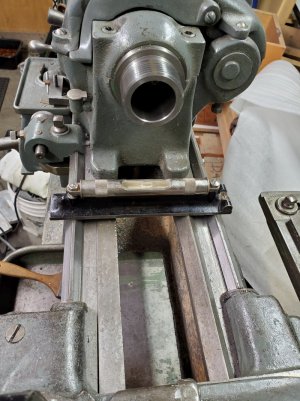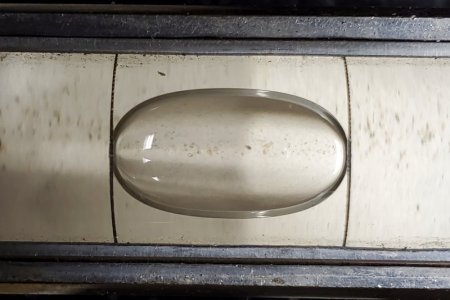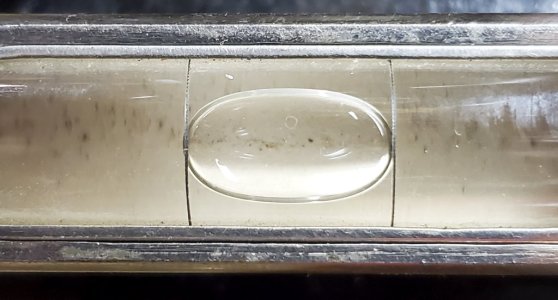And here's a couple of pictures of the construction process.
First though the tale of woe. I decided because the cast piece someone gave me was very soft that I'd better use coolant on the band saw. Haven't used coolant for decades. Pump wouldn't pump. Pulled off the pump and emptied major gunk out of the reservoir.

Once I had the pump out I grabbed the shaft with pliers and twisted it. A full turn and after that I could spin it by hand. After that the motor could turn it.
Spent more than an hour cleaning the tank. Then a just under a litre of Princess Auto Powerfist Water Soluable cutting oil and about 25 litres of water.
Then it took over two hours to cut the 4 disks. After the first two were cut I could start on turning them. First face one side of all 4 pieces in the 4 jaw chuck and drill a 1/2" hole. Then flip the thinest one and surface until all the saw marks are gone. That worked out to 15.6mm. My saw blade probably needs replacing or there are some alignment issues as it had issues cutting perfectly square blanks.
Next flip each blank and with the carriage locked at that position and just use the compound to feed in until the dial reads the same as the first piece. Measure. 15.6mm. Rinse and repeat two more times.

The above photo is a screen grab of a really short video showing my ELS driving the Z axis lead screw but the south bend set for power cross feed. Setting up feed rates let me go quickly towards the middle for a rough cut and as it returned to start I fed the compound in 0.005" and the return pass was slower and did a nice cleaning job.
Finally, although not really needed, I decided I wanted all 4 pieces the same diameter and concentric to the drilled (not bored) hole. Once again my ELS to cut each pass to bring it down to the same diameter which saved having to hover over it and I could do other things. Like spray WD-40 and brush away chips.
Notice that it was easiest, for me anyway, to put the disk on an existing half inch mandrel and turn it between centers. I could also have chucked the head stock end into a collet instead of a drive dog since I didn't need to end for end the work.

First though the tale of woe. I decided because the cast piece someone gave me was very soft that I'd better use coolant on the band saw. Haven't used coolant for decades. Pump wouldn't pump. Pulled off the pump and emptied major gunk out of the reservoir.
Once I had the pump out I grabbed the shaft with pliers and twisted it. A full turn and after that I could spin it by hand. After that the motor could turn it.
Spent more than an hour cleaning the tank. Then a just under a litre of Princess Auto Powerfist Water Soluable cutting oil and about 25 litres of water.
Then it took over two hours to cut the 4 disks. After the first two were cut I could start on turning them. First face one side of all 4 pieces in the 4 jaw chuck and drill a 1/2" hole. Then flip the thinest one and surface until all the saw marks are gone. That worked out to 15.6mm. My saw blade probably needs replacing or there are some alignment issues as it had issues cutting perfectly square blanks.
Next flip each blank and with the carriage locked at that position and just use the compound to feed in until the dial reads the same as the first piece. Measure. 15.6mm. Rinse and repeat two more times.
The above photo is a screen grab of a really short video showing my ELS driving the Z axis lead screw but the south bend set for power cross feed. Setting up feed rates let me go quickly towards the middle for a rough cut and as it returned to start I fed the compound in 0.005" and the return pass was slower and did a nice cleaning job.
Finally, although not really needed, I decided I wanted all 4 pieces the same diameter and concentric to the drilled (not bored) hole. Once again my ELS to cut each pass to bring it down to the same diameter which saved having to hover over it and I could do other things. Like spray WD-40 and brush away chips.
Notice that it was easiest, for me anyway, to put the disk on an existing half inch mandrel and turn it between centers. I could also have chucked the head stock end into a collet instead of a drive dog since I didn't need to end for end the work.



